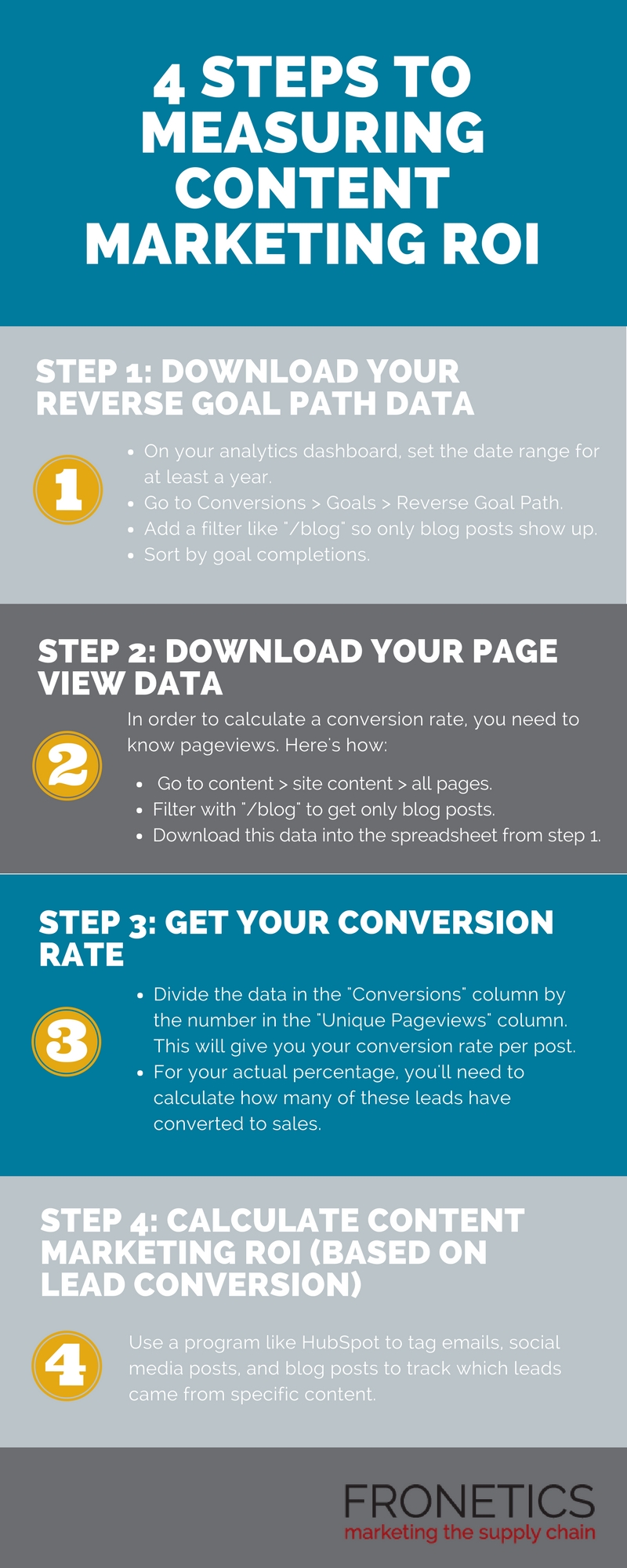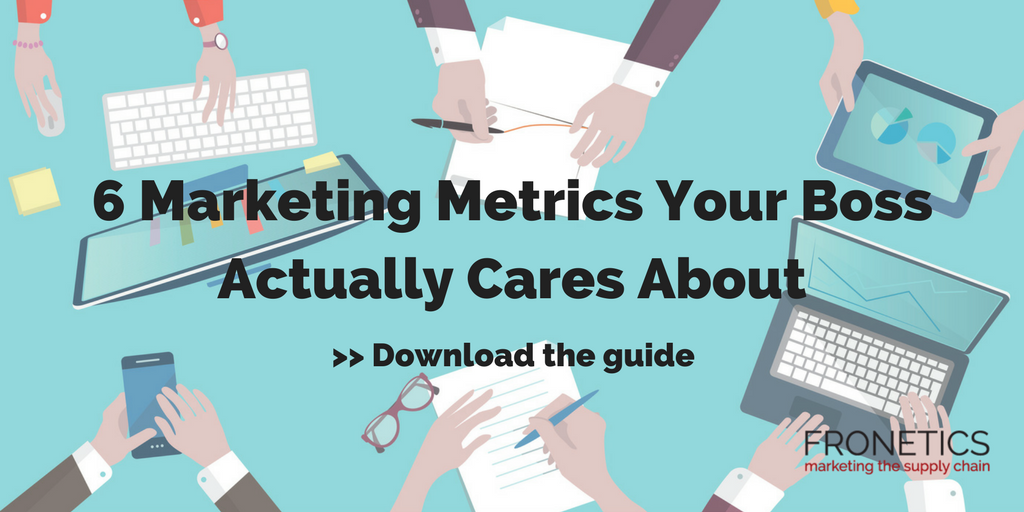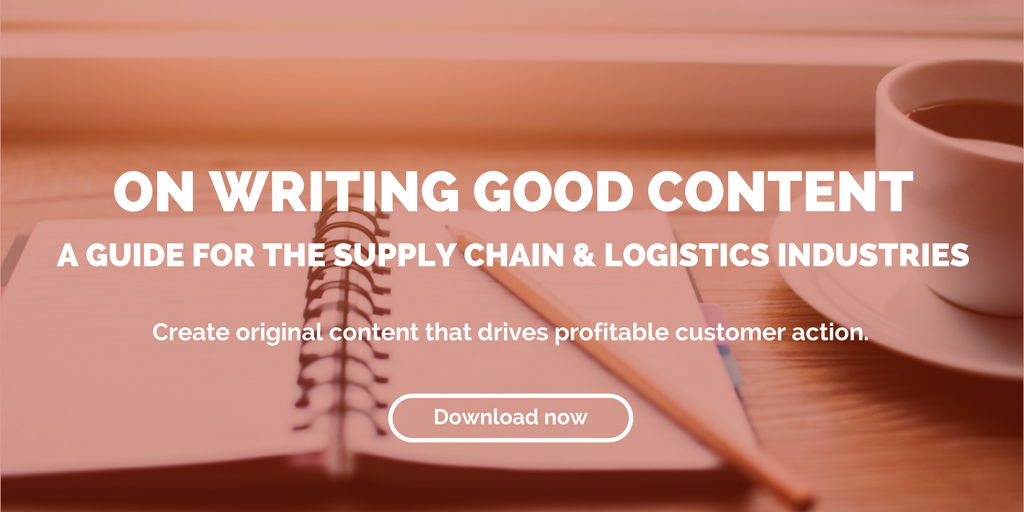
by Fronetics | May 10, 2018 | Blog, Content Marketing, Logistics, Marketing, Supply Chain
An important part of your content strategy should be optimizing historic blog content to ensure it’s attracting as much traffic as possible.
We all know that creating original content on a regular basis is important to improving SEO and attracting organic traffic to your website. But, here’s a surprise: Most of your traffic will come from older blog posts.
An important part of your content strategy should be optimizing historic blog content to ensure it’s attracting as much traffic as possible.
If you have a lot of content, that may scare you. (Sounds like a lot of work!) But, as with everything, being strategic about optimizing historic blog content will pay off many times over. Here’s how I suggest going about that.
Pick your posts
At Fronetics, about 80% of our traffic comes from posts that are 6 months old or older. HubSpot also discovered a similar trend: 76% of its monthly views came from old posts, as well as 92% of the company’s monthly leads!
[bctt tweet=”76% of HubSpot’s monthly views come from old posts and 92% of their monthly leads.” username=”Fronetics”]
But not all posts were created equal. In fact, HubSpot found they got about half of their monthly leads from only 30 posts, and they blog at a blistering pace of about 200 new posts every month. Going back and optimizing hundreds of your old posts is a waste of time.
Hunt through your analytics and look for historical blog posts with:
- High traffic and high conversion rates: Readers view these posts often and convert frequently after reading them. Found any of these? Congrats. Most companies won’t have more than 1 or 2.
- High traffic but low conversation rates: These are the posts are viewed often but don’t generate leads.
- Low traffic but high conversion rates: These posts only garner a small number of hits but do well generating leads due to a higher-than-normal number of call-to-action click-throughs.
All set? Have a list of good blogs to work with? Here comes the fun part!
5 tips for optimizing historic blog content
Here are 5 tips to squeeze the absolute most out of your older blog posts (in terms of leads and conversions).
1. Update the content.
Rework it for today. Take out anything outdated and use a little finesse to make it more relevant. Don’t overhaul it; that’s unnecessary for a well-performing post.
2. Spice up the call-to-actions.
You’ll want to pay special attention to this for the posts that have high traffic but low conversion rates. CTAs have evolved. Old ones just aren’t going to appeal.
Revamp the CTA placement and appearance, and think (hard) again about your CTA content. Consider the language of the CTA and whether it fits the reader’s goal. What keyword(s) are they using to find the page? And does the CTA reflect this?
There’s so much information out there on making strong CTAs, but the bottom line is the CTA must match the intent of the audience.
Keep it bold. Keep it clear. And make ‘em an offer they can’t refuse.
3. Relook at your keywords.
For the posts that do well converting leads but don’t get a lot of traffic, you’ll need to take a fresh look at keywords.
Trying to rank for certain keywords in each blog post you publish is a practice on the way out. But it still has merit here, as long as you understand it within the larger picture of restructuring your website content into topic clusters and pillar content.
People are changing how they search, and search-engine-optimizing these old posts to get more visibility is the goal.
And here’s the beauty of optimizing historical blog content: You already have the data to know which keywords your audience are using to find the posts. Then prominently feature the keyword(s) in several places.
4. Update your posts’ meta descriptions.
If you’ve done the hard work to update the CTA and the keywords, updating the meta description is a natural next step. Keep it as close to (but not over) 155-165 characters. Include your keyword(s). Explain the value of the post to the reader. And keep in mind your ultimate CTA goal. Everything should align to make the meta description a true synthesis of the post; if it doesn’t, go back and tweak a little more.
5. Republish and keep the URL.
Things that are “fresh” receive preferential treatment from Google. (We know it’s hard to believe when 2012 articles are at the top of your search results, but it’s true.)
But do not lose that original URL when you publish again. It pulls way more SEO “rank” than a new one. Keep the URL even if you updated the title of the post and the URL doesn’t match perfectly anymore. It’s OK.
(It’s not a bad idea to put in an editor’s note at the end of the article if the blog already has garnered comments, so your future audience won’t be confused by a publish date that is later than the date on the comments.)
And that’s it. 30 days after optimizing your historic blog content, go back and see how successful your efforts were. Track the metrics: post views, CTA click-throughs, lead generation, and keyword ranking. We’re betting they’ve gone up.
Measuring the success of your SEO strategy shouldn’t be done by measuring the success of one post at a time. But making the most of your best old posts is an important part of any good content marketing strategy.
Final tip
The final tip isn’t really about optimizing historic blog content, so let’s call it a ½ tip. Remember how Tip 1 recommended reworking the old posts but warned against overhauling them with large rewrites?
Well… Here’s the thing. If you have 12 historic blog posts you just optimized, you should write 12 new blog posts on that same content, too.
Recycle that good historic content into additional fresh content. After all, it’s what your audience is searching for!
Related posts:


by Fronetics | Apr 18, 2018 | Blog, Content Marketing, Logistics, Marketing, Social Media, Strategy, Supply Chain
Here are four simple steps to measure your company’s content marketing ROI and the success of your content marketing strategy.
Measuring your content marketing ROI gives you valuable insight into what’s working (and what’s not) with your content marketing strategy. It’s important to measure if your efforts are profitable so you know where to put your time and money.
Content marketing ROI is harder to quantify than just tracking how many likes your social media pages have. But tracking certain metrics is important for understanding how your content marketing activities are performing. Keeping a close eye on your ROI allows you to make cost-effective marketing choices and to avoid costly mistakes.
In the article, How to Measure Content Marketing ROI: A Simple 4 Step Process, eCommerce content marketing and SEO consultant Bill Widmer breaks down the simple four-step process that will quickly — and effectively — measure your content marketing ROI.
Every company has specific key performance indicators (KPIs) that help shape their marketing strategy. These KPIs will be the foundation for measuring your content marketing ROI.
Infographic: How to measure your content marketing ROI in four easy steps

(Made with Canva)
We all want to see the fruits of our labors. Whether launching a new social media campaign or creating new videos for your blog, we look for instantaneous numbers that will affirm we made the right choices. Calculating ROI might take some time – both in the few extra minutes to do the math and the amount of time that needs to pass before all the data is available — but that number will be invaluable to you.
Want to measure your content marketing ROI?
Related posts:


by Fronetics | Mar 15, 2018 | Blog, Content Marketing, Logistics, Marketing, Strategy, Supply Chain
Here are four simple steps to help you measure your company’s content marketing ROI and the success of your strategy.
Lean-startup pioneer Eric Ries said, “The only metrics that entrepreneurs should invest energy in collecting are those that help them make decisions.” In other words, measure the things that will tell you if an effort was profitable so you know where to put your time and money.
But most companies aren’t using the right metrics to track their content marketing ROI. For example, 83% of B2B enterprise companies (over 1,000 employees) use web traffic as their main metric for measuring content marketing ROI. A spike in homepage hits could be the result of your hard work, but it could also be ghost spam, or even both! So clearly, web traffic isn’t the most reliable metric.
Content marketing ROI is harder to quantify than checking a few quick numbers. But don’t give up hope. In the article How to Measure Content Marketing ROI: A Simple 4 Step Process, marketing consultant Bill Widmer breaks down a simple, four-step process that will quickly and effectively measure your content marketing ROI.
What is content marketing ROI?
Content marketing ROI is how much revenue you gain from content marketing in comparison with what you spend on creating and distributing content. It’s an actual percentage that shows how much revenue you gained vs. how much money you spent. And for a lot of businesses (and bosses), this percentage is very important. They want you to be able to prove that the marketing dollars that are going into your content marketing strategy are actually pulling in new business.
Every company has specific key performance indicators (KPIs) that help shape their marketing strategies. Here at Fronetics, we believe that your content marketing strategy should take these KPIs into consideration when thinking about your ROI:
- Website traffic
- Leads generated
- Conversion rate
- Direct sales
Obviously content marketing has more benefits than these four KPIs demonstrate — including better customer retention, brand awareness, and improved SEO — but to begin to measure your ROI, let’s focus on these four main points.
Measure content marketing ROI in 4 simple steps
1. Download your reverse goal path data.
Andy Crestodina, co-founder and CMO of Orbit Media, suggests:
- Go to your analytics dashboard. Set the date range for at least a year.
- Go to Conversions > Goals > Reverse Goal Path.
- Add a filter like “/blog” so only blog posts show up.
- Sort by Goal Completions.
After this step, you’ll be able see which of your posts have driven the most conversions. But you can’t stop there. These are simply conversion numbers. We want those numbers to become conversion rates, so let’s keep going.
2. Download your pageview data.
In order to calculate a conversion rate, you need to know pageviews. Here’s how to get that information:
- Go to Content > Site Content > All Pages.
- Filter with “/blog” to get only blog posts.
Download this data into the spreadsheet from step one.
3. Get your conversion rate.
Now here’s a little math for you. Divide the data in the “conversions” column by the number in the “unique pageviews” column. This will give you your conversion rate per blog post.
This will show you what your best-performing pieces of content are, and what posts need to be updated to gain more views and shares.
This information will give you valuable insight into the topics that your target audience are reading about and how you can better plan for high-ranking content in the future.
If you have posts or pages that are older — like over a year — and they haven’t gotten any views or conversions, it’s time to think about reworking them to have more appeal to your target audience.
For your actual percentage, you’ll need to calculate how many of these leads have converted to sales.
4. Calculate content marketing ROI based on lead conversions.
Here’s where things get a little more complicated, but still very manageable. You need to start putting tags on your leads according to the content they came from.
You can use programs like WordPress or Blogger to help you automatically tag any leads that came from a specific form. Assuming the form correlates to a single blog post, you will know that any leads with that tag came from that post.
You can also connect your leads with a CRM, such as HubSpot or SalesForce, and track which leads came from specific emails. These programs easily integrate with your analytics and email marketing platforms for up-to-date numbers and data.
Related posts:


by Fronetics | Mar 12, 2018 | Blog, Content Marketing, Logistics, Marketing, Social Media, Supply Chain
Here’s how to quantify the impact of content marketing on brand awareness, a notoriously difficult benefit to measure.
A successful content marketing strategy strengthens the relationship between brands and their target audiences. And brand awareness is a key component to any successful content marketing strategy. Ultimately, the more aware audiences are of your brand, the more likely they are to buy your products or services.
To properly measure the impact of your content marketing, you must start at the beginning, with the overall goals for your content marketing strategy. What kind of content are you creating? Why are you creating this content? How will this increase sales or grow your business?
A lot of our customers include increasing brand awareness among their content strategy goals. But this is a very difficult objective to quantify. How can you measure how familiar people are with your brand?
Here are four metrics we recommend for tracking the impact of content marketing on brand awareness.
4 metrics to measure the impact of content marketing on brand awareness.
1. Social media reach
Tracking the reach of your social media content is a good gauge of the impact it’s having on your brand awareness. Companies can waste a lot of time trying to track down information on various social media accounts; don’t fall into this trap.
Use tools, like Shared Count, that show how many times a piece of content has been shared on social media. Shared Count accurately tracks the social reach of your content on the most popular social media sites — including Facebook, Twitter and LinkedIn — to easily keep track of your social reach. In turn, you can discover the impact your social reach is having on your brand awareness.
2. Brand mentions
Not to state the obvious, but if people are talking about your brand online, it’s safe to assume they are aware of you. There’s a great deal of value in knowing what customers are saying about your company and your products/services. Monitoring brand mentions online can provide honest feedback and objective insight from current and potential customers.
There are several tools to help you track brand mentions online. Here at Fronetics, we prefer the ease of Google Alerts, which allows you to set up custom alerts when your brand is mentioned online. We also use Hootsuite, where you can track brand mentions, as well as keywords and phrases, across all of your social media platforms.
3. Media mentions
Media mentions differ from brand mentions in their origin. Media mentions come directly from publishers, instead of customers. These mentions include any media coverage — TV, print, social media, interviews — that include your brand. Remember, if publishers are talking about your brand online as a result of the content you’re creating, it’s impacting your brand awareness.
And let’s not forget about linkless mentions. As Google and other search engines continue to update their algorithms, it’s crucial to update your monitoring practices. Linkless backlinks are becoming increasingly popular and can have a huge impact on your brand awareness (and SEO!).
4. Branded searches
Knowing how many people are searching for your specific brand tells you a lot about how well known your brand is. Using online tools, such as Google Adwords or Moz, you can track the searches for your products, blogs, social media platforms, and any other variation that you find useful. These tools are free, easy to use, and perfect for determining if your company is popping up when customers are searching.
Using these tools to measure brand awareness offers clues that customers are finding your company in their search efforts. If the needle is not moving in a positive direction, always adjust your strategy to until you find what works for your business.
Drawing the public’s attention to — and heightening their knowledge of — your business ultimately generates leads. And some of those leads will turn into sales. But, let’s be honest: this doesn’t happen overnight. And it’s often difficult to quantify.
That’s not a reason to throw in the towel. There are ways to measure the work that you’re putting into your content marketing program. Using these metrics, you can start tracking the impact of content marketing on brand awareness.
Related posts:


by Fronetics | Mar 8, 2018 | Blog, Content Marketing, Logistics, Marketing, Strategy, Supply Chain
Use these 4 steps to determine the topic clusters that will be best for driving organic traffic to your business’ website.
You’ve determined your pillar content and written your pillar pages. Now what? It’s time to develop topics clusters.
Topic clusters show search engines that your website contains breadth and depth on a particular subject, which will help them decide to show your page over others in a user’s search for that subject.
Determining what topic clusters to use can be overwhelming — as can figuring out how to optimize blog posts that contain cluster content. Let’s take a step back and think a little about what a topic cluster is.
HubSpot Academy has a great succinct summary: “Topic clusters are comprised of a pillar page and subtopic content that you’ve compiled for each of your core topics.”
So how do you go about developing topic clusters? We’ve put together a four-step guide to get you started.
4 steps to developing topic clusters
1) Choose your topic.
This is all about determining where you can or strive to be a thought leader. Pick topics that are fundamental to your business, places where you can be a resource for potential buyers and industry peers. Define these topics with a name that summarizes the content it will address.
Chances are, you’ll have some supporting content already. Conducting a content audit will help you determine how much you have in place already.
2) Compile subtopics.
HubSpot recommends having “6-8 subtopics that address specific questions your customers may be exploring related to the core topic of your pillar page.” Other sources recommend between 10-20 subtopics. It depends on how broad your main topic is. (But if you can come up with more than 20 subtopics, your topic is definitely too broad!)
Conduct a brainstorming session with your team to think about relevant content that your target buyers would seek out when researching products and solutions.
Simple Marketing Now blogger Christine B. Whittemore suggests starting with identifying the problems your buyer persona faces. “Map out 5-10 core problems that your core persona has. Use research… to truly understand your buyer persona problems, including the world used to describe them.”
3) Develop pillar pages.
Now that you have a list of topics and subtopics, you need to develop your pillar pages. These pages will extensively — and broadly — cover each main topic, and they will include links to each subtopic.
Inbound Marketing Specialist Sarah Seward suggests using “relevant pictures, high-quality and interesting content, compelling headers, and any additional, related resources, such as a custom graphic visually demonstrating your expertise on a topic.”
4) Create!
Now it’s time to create your content (or brush up existing content you discovered in your audit). Be sure to link pages covering your subtopics to your pillar pages, using the correct anchor text. That means hyperlinking words that are relevant to the topic and subtopics.
Additionally, you can link subtopics together where appropriate. The more often you can create relevant links, the better.
Now repeat this process until you’ve created several topic clusters that best define your business. This SEO strategy will help ensure that prospective customers that are searching for products or services like yours will be more likely to visit your website and patronize your business.
Related posts:










